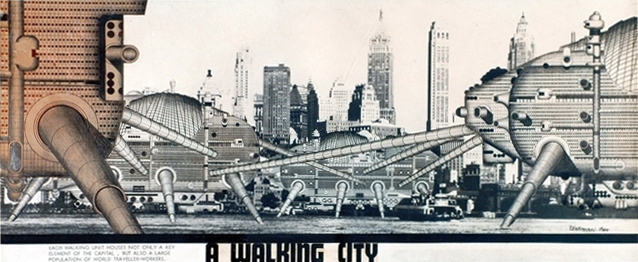
Ron Herron. Walking City In New York, 1961-1974. Colored collage. Courtesy of the Archigram Archival Project and the Herron Archives.
“Innovation” is the buzzword of the moment and it’s found its way into just about every corner of modern life in our ceaseless pursuit of the “new and improved.” We often use it interchangeably with its close cousin, “Invention,” but the two are not exactly synonymous. While “Invention” speaks of paradigm-shifting ideas that open up a whole new world of possibilities (think: the printing press, electricity, the internet), “Innovation” builds on those inventions with novel takes on implementation, which are often times driven and informed by market forces. It’s the difference between inventing the telephone and releasing a new mobile phone (“Version 8 is better than ever!”).
While “Innovation” is pervasive it’s “Invention” that we need now more than ever. “Innovation” is bound to what already exists—it essentially asks us to make improvements to known products, systems, and processes. In doing so, it limits our potential for exploration—even exponential innovation offers us only incremental change. “Invention,” on the other hand, asks us to conceive an entirely new, bold, and ambitious vision. It prompts us to imagine how things could be, offering new propositions that aren’t bound by the realities of how things are.
While we typically associate “Invention” and “Innovation” with the science and technology industries, I believe the arts have something important to offer here. After all, no one has more power of imagination than artists. Whether it’s in the form of utopian manifestos in the Bauhaus, Futurist, or Situationist traditions, or the current trend towards activist, community-driven, and social impact-focused artistic interventions, there is no shortage of new ideas that seek to critique and re-envision our society.
What’s interesting about the current moment is that we have an unprecedented ability to put our ideas into action. While hierarchies are by no means a thing of the past, the Information Age’s decentralized and networked qualities give individuals more power than they’ve ever had. We can bypass gatekeepers to connect with collaborators and constituents directly, crowdsource resources, and build grassroots movements virtually overnight. How we leverage this opportunity to bring more “Invention,” more radically new ideas to the forefront, is the question I’m most interested in answering.
From my position as Director of NEW INC, the New Museum’s cultural incubator for art, design and technology, I hope to create an environment that can foster and promote more “Invention.” That means supporting experimentation, investigating the edge cases, and going against convention. But I think it also calls for a kind of “practical idealism” that considers how we can go from ideation to execution, how we can move beyond speculation and theory to take steps towards actually building the things we dream about.
Looking at the state of the world today it seems that now, more than ever, we need “Invention” combined with Action to get us through dark times, and be the spark that lights the way forward.



